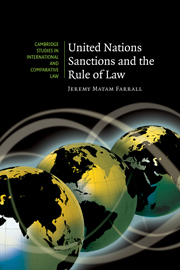Book contents
- Frontmatter
- Contents
- Extended Table of Contents
- Preface
- Abbreviations
- Part I Setting the scene
- Part II The evolution of the UN sanctions framework
- Part III UN sanctions in practice
- Part IV Strengthening the rule of law
- Appendix 1 Summary of policy recommendations
- Appendix 2 Summaries of UN sanctions regimes
- Appendix 3 Tables
- Bibliography
- Index
- Cambridge Studies in International and Comparative Law
Appendix 1 - Summary of policy recommendations
Published online by Cambridge University Press: 26 June 2009
- Frontmatter
- Contents
- Extended Table of Contents
- Preface
- Abbreviations
- Part I Setting the scene
- Part II The evolution of the UN sanctions framework
- Part III UN sanctions in practice
- Part IV Strengthening the rule of law
- Appendix 1 Summary of policy recommendations
- Appendix 2 Summaries of UN sanctions regimes
- Appendix 3 Tables
- Bibliography
- Index
- Cambridge Studies in International and Comparative Law
Summary
Increasing transparency
Whenever possible, the Security Council should hold its discussions concerning the potential or actual application of sanctions in public.
Sanctions committees should also meet in open session when possible. All formal committee meetings should also become a matter of public record, with verbatim transcripts and/or summary records being released for public distribution. The Security Council could ensure that this takes place by so stipulating in its decisions outlining committee mandates.
When the Council votes on a draft resolution that seeks to impose or modify sanctions, Security Council members should speak in explanation of their vote. The practice that has become prevalent, according to which the Council has imposed sanctions with little or no public discussion, should cease.
When determining the existence of a threat to the peace, breach of the peace or act of aggression, the Council should identify as clearly as possible the precise nature and cause of the threat to the peace, breach of the peace or act of aggression.
Where possible, such determinations should occur some time before sanctions are applied, in order to demonstrate that they are not mere determinations of convenience, made in order to justify the immediate application of sanctions.
- Type
- Chapter
- Information
- United Nations Sanctions and the Rule of Law , pp. 244 - 246Publisher: Cambridge University PressPrint publication year: 2007



